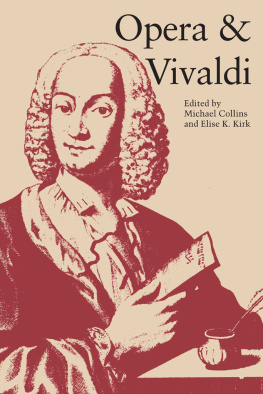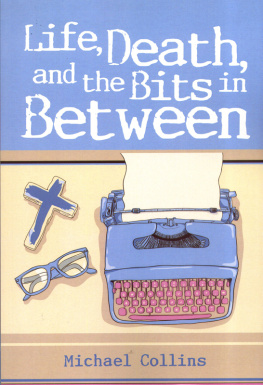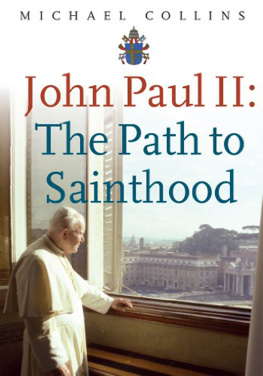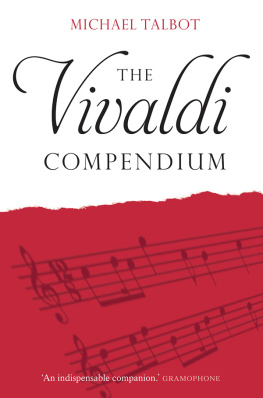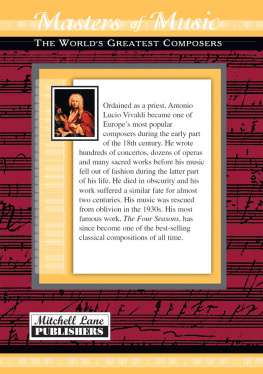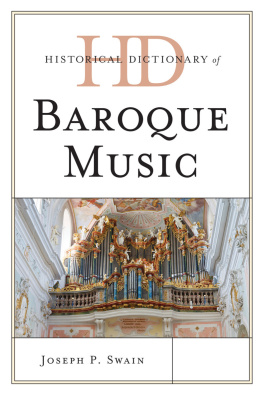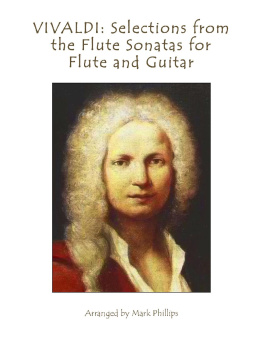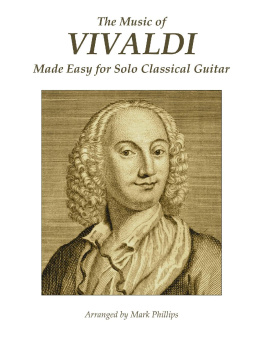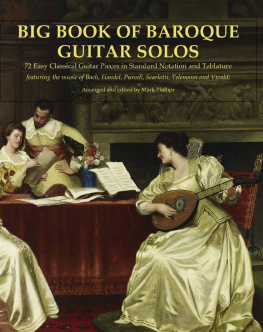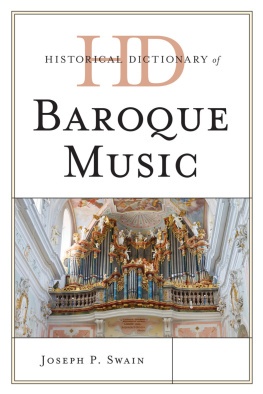Michael Collins - Opera and Vivaldi
Here you can read online Michael Collins - Opera and Vivaldi full text of the book (entire story) in english for free. Download pdf and epub, get meaning, cover and reviews about this ebook. year: 1984, publisher: University of Texas Press, genre: Non-fiction. Description of the work, (preface) as well as reviews are available. Best literature library LitArk.com created for fans of good reading and offers a wide selection of genres:
Romance novel
Science fiction
Adventure
Detective
Science
History
Home and family
Prose
Art
Politics
Computer
Non-fiction
Religion
Business
Children
Humor
Choose a favorite category and find really read worthwhile books. Enjoy immersion in the world of imagination, feel the emotions of the characters or learn something new for yourself, make an fascinating discovery.
- Book:Opera and Vivaldi
- Author:
- Publisher:University of Texas Press
- Genre:
- Year:1984
- Rating:3 / 5
- Favourites:Add to favourites
- Your mark:
- 60
- 1
- 2
- 3
- 4
- 5
Opera and Vivaldi: summary, description and annotation
We offer to read an annotation, description, summary or preface (depends on what the author of the book "Opera and Vivaldi" wrote himself). If you haven't found the necessary information about the book — write in the comments, we will try to find it.
A collection of papers on Baroque opera, discussing the operatic works of Vivaldi, Handel, and other Baroque composers as well as the characteristics of the genre.
Opera and Vivaldi — read online for free the complete book (whole text) full work
Below is the text of the book, divided by pages. System saving the place of the last page read, allows you to conveniently read the book "Opera and Vivaldi" online for free, without having to search again every time where you left off. Put a bookmark, and you can go to the page where you finished reading at any time.
Font size:
Interval:
Bookmark:

Orlando, played by Marilyn Horne, before the Temple of Infernal Hecate in act 3 of Vivaldis Orlando furioso, the Dallas Opera, 1980. Photo: Phil Schexnyder. Frontispiece courtesy the Dallas Opera.
Opera & Vivaldi
Edited by Michael Collins and Elise K. Kirk

University of Texas Press,
Austin
Copyright 1984 by the University of Texas Press
All rights reserved
First Edition, 1984
Requests for permission to reproduce material from this work should be sent to Permissions, University of Texas Press, Box 7819, Austin, Texas 78712.
Library of Congress Cataloging in Publication Data
Main entry under title:
Opera and Vivaldi.
Includes index.
1. Opera18th centuryCongresses. 2. Vivaldi, Antonio, 16781741. Orlando. 3. Vivaldi, Antonio, 16781741. Operas. I. Collins, Michael (Michael B.), 1930 . II. Kirk, Elise K. (Elise Kuhl), 1932 .
ML1703.063 1984
782.1'09'033
83-23557
ISBN 0-292-70746-0
ISBN 978-1-4773-0065-7 (library e-book)
ISBN 978-1-4773-0066-4 (individual e-book)
doi:10.7560/707467
INTRODUCTION
Vivaldis Orlando furioso: The Dallas Opera Production and Symposium
by Elise K. Kirk
In November 1980, the Dallas Opera produced the first fully staged performance in America of Antonio Vivaldis opera Orlando furioso. It was the first time an opera by Vivaldi had ever been staged in this country. Orlando furioso had its premiere at the Teatro SantAngelo in Venice in 1727, and in 1978 was revived through the research of Claudio Scimone for Veronas Teatro Filarmonico in celebration of the 300th anniversary of Vivaldis birth. This production, featuring Marilyn Horne with sets and costumes by Pier-Luigi Pizzi, was brought to Dallas and conducted by Nicola Rescigno at Fair Park Music Hall on November 28, December 1, and December 3, 1980. In addition to Miss Horne, who sang the role of Orlando, the cast included Ellen Shade as Angelica, princess of Cathay; Dano Raffanti as the Saracen Medoro; Gwendolyn Killebrew as the sorceress Alcina; James Bowman as the Saracen knight Ruggiero; Rose Taylor as Bradamante, cousin of Orlando; and Nicola Zaccaria as the Christian knight Astolfo.
The operas libretto by Grazio Braccioli is based loosely upon Lodovico Ariostos popular epica legendary masterpiece that combines tales mainly from Arthurian and Carolingian cycles. The Christian knight Orlando, or Roland as he is called in the Carolingian Chanson de Roland, is the nephew of Charlemagne, and his romantic adventures are recounted with wit and capricious imagination in Bracciolis colorful libretto. Braccioli also provided the libretto for Ristoris Orlando furioso of 1713, an opera that Vivaldi revised in 1714 to replace his unsuccessful Orlando finto pazzo of the same year. It was the 1714 revision, as John Hill details in of this book, that later became the source for Vivaldis Orlando of 1727 (renamed Orlando furioso for the Verona and Dallas productions).
and its relationship with the Ariosto story is apparent when one considers the synopsis in the appendix to this volume. Braccioli himself offers the following overview of the weaving and melding of events from Ariostos epic in his preface to the 1713 libretto:
Only the island of Alcina... is the setting in which the action takes place, although in the vast epic the numerous exploits involve half the world, so to speak. Such actions have been limited by us... to the love, madness and recovery of Orlando. The loves of Bradamante and Ruggiero, Angelica and diverse passions of Astolfo serve to accompany this action and lead it to its end.
To witness a performance of a Vivaldi opera is a rare experience by any measure. The famed Prete Rosso, known principally through his instrumental works, claimed toward the end of his life to have written ninety-four operas. While modern scholarship identifies at least forty-nine, texts are extant for only twenty-six of these.
It is little wonder that the Dallas Operas Orlando furioso generated an enormous amount of interest both here and abroad. Besides being an American premiere of a beautiful work that had slumbered in oblivion for about 250 years, it was a very enjoyable and successful enterprise. Marilyn Horne sang with extraordinary bravura and power. Critic John Ardoin claimed rightfully that there is no other singer today who could turn with comparable ease from a pathetic, sustained aria such as Fonti di pianto to the virtuoso ragings of Orlando which followed. Other members of the cast were dramatically and musically convincing as well as vocally compatible. Conducting with vitality and sensitivity, Nicola Rescigno exhibited a special affinity with Vivaldis warm, lyrical lines and transparent textures. He interpreted the scores brilliant instrumental and vocal passages and constantly shifting expressive moods with an awareness of Vivaldis dramatic powers.

FIGURE 1. The sorceress Alcina (Gwendolyn Killebrew) tries to seduce the knight Ruggiero (James Bowman), who had recently arrived on his flying horse. Act 1, scene 5, from Vivaldis Orlando furioso, the Dallas Opera, 1980. Photos: Phil Schexnyder.
Pier-Luigi Pizzis stage designs for the Dallas Orlando reminded some viewers of an old-fashioned valentine. They seemed to capture the spirit of eighteenth-century theatricality in a stylish sort of Baroque fantasy, to use Maestro Pizzis own phrase. The floor was black marble, and scenes changed deftly, primarily at the rear of the stage, against a background of dark reflecting mirrors. There were cupids, boats, leafy bowers, temples with gleaming white columns, a flying golden horse, an ornate bed for sorceress Alcina, and an array of Baroque contrivances simulating the machines that captivated eighteenth-century audiences. Art historian Alessandra Comini observed during the final day of the concurrent symposium that the marvelous, huge mirror, which rose up at the beginning of the opera and descended at the end, allowed the audience to experience genuinely the eighteenth-century quadratura painting and perspective of an artist such as Tiepolo. Pizzis costumes, in turn, had an aura of Tiepolo about them. Except for Marilyn Hornes voluminous black robe, their colors reflected the warmth and richness of the Baroque masters famed frescos.
Howard Mayer Brown, Schevill Distinguished Service Professor at the University of Chicago, spoke of the vitality and charm of the Dallas production in his BBC review delivered in December 1980: Rescigno and his company had certainly translated 18th-century conventions into modern terms that they thought their audience could better understand. This was the best such production I had ever seen.
Who could ask for more? said Andrew Porter, who also found the Dallas Orlando a wealth of beautiful melodies, fine singing and spectacular decor. But more there was, he claimed. From November 28 through December 1, the Dallas Opera held an international symposium, Opera and Vivaldi: Reflections of a Changing World, in cooperation with the Meadows School of the Arts, Southern Methodist University. Bringing together twenty-nine noted participants from seven countries, the symposium was the first of its kind to explore the relatively obscure field of opera seria, and with the attendant production attracted press and opera luminaries from all over the world. Held in the universitys Caruth Auditorium, the meeting drew excellent reviews. Andrew Porter, for example, called the symposium a bold venture, and added that whoever next puts on, takes part in, or, for that matter, attends a Baroque opera should be able to do so with mind, ears, and eyes sharpened by what was revealed at the Dallas symposium.
Next pageFont size:
Interval:
Bookmark:
Similar books «Opera and Vivaldi»
Look at similar books to Opera and Vivaldi. We have selected literature similar in name and meaning in the hope of providing readers with more options to find new, interesting, not yet read works.
Discussion, reviews of the book Opera and Vivaldi and just readers' own opinions. Leave your comments, write what you think about the work, its meaning or the main characters. Specify what exactly you liked and what you didn't like, and why you think so.

